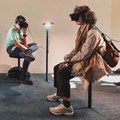#BizTrends2020: Imagine the impossible

For the coming year, there are a few unique trends are predicted to drive business growth into 2020 and beyond – they are:
1. Understanding, being relevant to and capturing the millennial demographic
Whilst some of us remember a time before the internet, millennials were born into a world with technology and the internet and it’s a world that is ingrained in everything they do.
These are also the largest chunk of the consumer market, which means that companies and their brands have to transform to adapt to this digital age.
Companies who fail to embrace digital business transformation will be extinct, because the internet age is has only just begun.This is proven by platforms such as YouTube that are making digital marketing more accessible to millennials. According to a VidMob survey, “59% of Gen Z respondents said they use their YouTube app a lot more than they did a year prior,” and companies like TikTok, which is a mobile-centric video platform, grew exponentially in just a few years.
With 500 million active users worldwide, TikTok ranks ninth amongst social networking platforms and ahead of the likes of LinkedIn, Twitter, Pinterest and Snapchat.
2. Knowing technology and how to use it to drive your business to greater heights
We are smack bang amidst the 4th Industrial Revolution (4IR) and technology is evolving faster than anyone could ever have predicted a few years ago. Companies that don't keep up with some of the major tech trends will be left behind.
Therefore, understanding the key trends for companies brings with it the opportunity to leverage opportunities and in so doing, grow. There are seven most imminent technological trends that everyone should get ready for and embrace for 2020 and beyond:
- a. Using AI to improve customer service and experience
AI (Artificial Intelligence) is one of the most transformative technological evolutions the digital era. Most forward-thinking companies have already started exploring the use of AI to improve their customer service and experience, as well as to streamline their operations. The use of AI will not only grow next year, consumers will become used to AI engagement as AI continues to have a significant impact on the world economy.
Even smaller uses of AI and algorithms can improve the consumer experience in most industries. Spotify, for example, already uses artificial intelligence to make the listening experience more personal by creating customised sessions for each user. Using smart technology will benefit both companies and consumers.
- b. Using 5G data networks
The 5th generation of mobile internet connectivity provides very fast download and upload speeds and more stable internet connections. Whilst 5G mobile data networks were only launched last year, data in South Africa remains expensive and the implementation of 5G data networks are not cheap for mobile operators, which is why it is limited to a few confined areas and major cities.
This year, the use of 5G networks is expected to take off and consumers can expect more affordable data plans with access to 5G networks, which means brands need to factor more and more mobile channels into their communication plans.
With super-fast data networks, the ability to access information whilst on the move and what was once considered the impossible, will become the norm as this advancement in technology will enable machines, robots, and autonomous vehicles to collect and transfer more data than ever before, thereby enabling growth of the Internet of Things (IoT) and smart machinery.
- c. Autonomous driving
We may not be at the stage where we can expect to routinely travel in, or even see, autonomous vehicles this year, these vehicles no doubt continue to intrigue consumers as we await their launch into the mainstream automotive market with great excitement.
Tesla CEO, Elon Musk already said that he expected his company to create a truly “complete” autonomous vehicle by 2019 and even though his ambition was not realised last year, this year, we will see a spike in the number of vehicles capable of operating with a lesser degree of autonomy, for example, automated braking and lane-changing will become increasingly common.
And that’s not all, other in-car systems not directly connected to driving – for example security and entertainment functions will most certainly become more automated and reliant on data capture and analytics.
Google's sister-company Waymo has just completed a trial of autonomous taxis in California, where it transported more than 6,200 people in the first month.
We can expect autonomous driving to grow beyond cars as the trucking and shipping industries become more technologically savvy and are slowly embracing more autonomous breakthroughs. This will only increase in 2020 and beyond.
- d. Using technology for personalised and predictive medicine
The healthcare industry has always been at the forefront of technology, using technology to constantly improve at an unprecedented rate.
Wearable devices such as smartwatches have given companies the ability to capture data and by doing so, increasingly predict and treat health-related issues in consumers before any symptoms are even experienced.
Consumers are therefore becoming more demanding of personalised medical treatment and access to medicine or precision medicine, as it is more commonly referred to in the medical world.
The use of technology affords doctors the opportunity to accurately prescribe medicines and apply treatments when they incorporate a data-driven understanding of how effective they are likely to be for a specific patient.Throughout 2020, we can expect to see new applications of predictive healthcare and the introduction of more personalised and effective treatments to ensure better outcomes for individual patients.
- e. Incorporating image recognition or computer vision
Image recognition or in computer terms, “vision” is the use of systems that are able to identify items, places, objects or people from visual images collected by a camera or sensor.
This technology allows consumers to use their smartphone camera to recognise an image it's capturing. Imagine what this means for brands!
In 2020, we are going to see computer-vision equipped tools and technology being used more and more. The use of this technology is paramount for how autonomous cars will “see” and navigate their way around danger.It is anticipated that production lines will incorporate computer-vision cameras, to watch for defective products or equipment failures and security cameras will be able to warning us of things that seem unusual, which will eliminate the need for 24/7 monitoring.
Facial recognition is already being widely adopted and used for to control access to smartphones – for example, Apple's FaceID, and how Dubai airport uses facial recognition to enable a much better customer journey. The use-cases will only grow in 2020.
- f. Using Extended Reality (XR) to create more immersive digital experiences
XR is the new ‘buzz phrase’ that covers a number of new and emerging technologies that are being used to create more immersive digital experiences for consumers. What it is, is a combination of virtual, augmented and mixed reality. Sounds impossible, right!
Well, it very much a part of the world we already live in. Virtual reality (VR) provides a fully digitally immersive experience, where consumers are able to enter a computer-generated world using headsets that blend out the real world. Augmented reality (AR) overlays digital objects onto the real-world using smartphone screens or displays, pretty much like Snapchat filters.
Mixed reality (MR) is an extension of AR and this enables consumers to interact with digital objects placed in the real world, like playing a holographic piano placed in a room via an AR headset. Pretty soon, consumers will be able to look at and have an immersive experience or products before they purchase them.
- g. Using Blockchain technology
The use of Blockchain technology is a trend that has already been widely predicted since 2017/2018, but most companies haven’t quite embraced it yet. 2020 could finally be the year when that changes. Blockchain is an encrypted digital ledger, used to record transactions securely.
During 2019, some tech commentators started arguing that the use of Blockchain technology was over-hyped and not as useful as initially predicted, however companies such as FedEx, IBM, Walmart and Mastercard continue investing extensively in the use of Blockchain, which is leading to adoption of Blockchain by more and more companies.
Rumour has it that Facebook will launch its own Blockchain-based crypto currently called Libra, which will no doubt create a lot of buzz.
3. The need to ‘go green’
Protecting the environment is paramount. More and more consumers are adopting a green lifestyle.
Beyond Meat is a plant-based protein manufacturer that has increased its stock prices by more than three times since its IPO launch however, for consumers, the eco-conscious lifestyle doesn’t stop at vegetarian diets and organic hygiene products.
Lunya – a popular women’s-clothing maker, manufactures its products from natural fabrics and fibres. Their sleepwear and intimate lines use Pima cotton for both durability and comfort.
The use of natural materials lowers the carbon footprint of companies and that of individual consumers. It’s a win-win solution, because it is no longer enough to be green anymore, companies are expected to help consumers understand the importance of making eco-friendly choices.
Those companies that do this properly will add value that authentically resonates with consumers.
4. E-Commerce, e-commerce, e-commerce
E-commerce will continue to dominate and in 2020 and beyond, global e-commerce is expected to reach around $5trillion, as reported by Statista. This will drive retailers to move investments from brick-and-mortar storefronts to online stores.
The success of online retailing has already been proven the world-over but locally, online stores such as Superbalist and Zando showcase the power of online shopping and how those retailers such as Stuttafords that failed to innovate closed down.As more retailers appear online, there is no limit to what can now be sold or purchased online.
5. All-encompassing digital platforms are paramount for 2020 and beyond
Companies need to provide more services and options to their customers, which has given rise to the demand for all-in-one platforms to handle secure financial transactions.
Consumers and business owners have an appreciation for the ability to accomplish more than one of their goals with any one particular vendor, and these all-encompassing digital platforms are not only gaining popularity but also becoming more necessary.
Consumers are demanding more contactless credit options and the ability to pay with cryptocurrency or their phone. Consumers are also demanding high security and instant, 24-hour access to funds.The need for digital transformation specialist companies like Sapient will become more necessary to guide companies through this ever-changing digital business transformation maze in order to move into 2020 and beyond.
In a nutshell, competition for the acquisition of customers is fierce and will not change in the coming year. If anything, adapting to the changing consumer market will be crucial for business success this year.
It is therefore so necessary for companies to not only know but also understand and embrace what consumers are demanding and where they are spending their money.Companies need to make the right investments for the year ahead and beyond, and jump onto the trends mentioned as these will definitely impact their opportunity to not only grow but even survive in these tough economic times.

About Odette van der Haar
Odette van der Haar joined Publicis as the MD from 1 September 2019, before which, she was the CEO of JWT Jhb. She was also CEO of the Association for Communication and Advertising (ACA) (www.acasa.co.za), the industry body of the SA advertising and communications sector, and previously headed up Sentech's Advertising, Events and Sponsorships portfolio...Related
Marketing budgets: A catalyst for ESG transformation 3 Apr 2025 Why the Tesla backlash could help electric cars finally go mainstream 1 Apr 2025 Is Tesla’s sales slump down to Elon Musk? 18 Mar 2025 #InternationalWomensDay2025: Sinmisola Hughes-Obisesan - A visionary driving Africa's creative future 7 Mar 2025 Duolingo's owl 'killed' by Tesla Cybertruck in viral campaign 14 Feb 2025 Mining industry stands to win from Trump Arctic interests 8 Jan 2025




























































